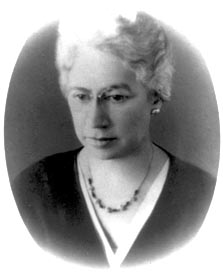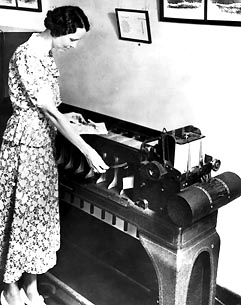The Bureau: Clara Parsons
Florence de Forest was 24 in 1893 when she and Frederick Duel took on the task of setting up the State's Bertillon System. For 21 years she remained in charge of the Bureau until a now-repealed civil service law which forbade married couples from working together forced her resignation.
On July 31, 1914, Miss de Forest and Frederick Duel were married. The following day she relinquished her position to Clara Parsons.

Clara L. Parsons, Chief of
NYS Bureau of Identification,
9/1/14 -- 2/21/22.
|
Miss Parsons . . . [had gone] to the Albany Business College to prepare for a clerical career . . . In June 1908, a stenographer position opened in the State Prison Department. She took the job; it paid 40 dollars a month . . . The promotion as Head Bertillon at the time of Miss de Forest's retirement elevated Miss Parson's salary to 100 dollars per month and enabled her to move her mother and sisters to Albany . . .
Miss Parsons harbored an abiding mistrust and dislike of men and refused to hire anyone but women into her department . . . Although fingerprinting had become the official means of identification in 1913, the Bertillon Indexers remained reluctant to embrace the new system. Those with the least seniority classified fingerprints and, as Miss Parsons was the most senior Indexer, she did not concern herself with anything beyond the Bertillon Files.
In 1918, when the Prison Department was reorganized, the fingerprint and Bertillon files were combined into one bureau and Miss Parsons was promoted to Bureau Chief. All State Prisons were told to record Bertillon measurements on the fingerprint cards designed by Edward Parke. The old-style Bertillon cards would no longer be accepted at the central office for filing. It was at this time that Miss Parsons took up the study of fingerprints.
She soon became an avid proponent of the system, however, and lectured extensively on the subject, devoting her life to the promotion of fingerprint identification. She regretted the fact that fingerprints were generally associated with criminal behavior and led the movement for universal fingerprinting.
In 1928 the Prison Department was reorganized again and was renamed the Department of Corrections. The Bureau of Identification expanded into the Division of Identification and its files moved from the Plaza Building on Broadway, where they had been housed for just over a year, to 11 North Pearl Street.
Laws passed in that year expanded the range of fingerprintable offenses and the annual influx of cards rose from 20,000 to 53,000. The identification files moved again, in 1930, to the Alfred E. Smith
Office Building, taking up the entire 17th floor.
By then, the Division of Identification was receiving 64,000 prints a year. The 28 employees could classify and file only about half that number and the backlog grew to unmanageable proportions. Miss Parsons' response was to work harder and longer.
In 1931, the Division stopped the recording of Bertillon measurements. In commemoration of the event, Miss Parsons wrote a brief history about the introduction of identification systems into New York State. In her essay,
she repeatedly professed her belief that the Bertillon files would always remain a part of the State's Identification Bureau. Captain James Parke was mentioned only briefly and never identified as the author of the fingerprint system. Edward Parke's contributions were entirely omitted.
By the 1930's, New York's Division of Identification was world known and Miss Parsons had risen to national prominence among identification orofessionals . . . On February 21, while giving another lecture at the Friendship House of the First Lutheran Church of Albany, Miss Parsons suffered a brain hemorrhage and died within the hour.
Mary Morton Austin
[With] the untimely death of Miss Parsons . . . he position of Director automatically fell to her assistant, Mary Morton Austin.
Miss Morton was born and grew up in Schodack, N.Y. She became a Bertillon Indexer on September 15, 1909 at the age of 20, and learned fingerprint classification from Charlotte Pangburn in 1918. . . By 1936 when she took over the Division, the position of Director could only be held by someone who had passed the associated Civil Service Exam. Although Mrs. Austin had taken and passed the exam, she had not done as well as Miss Parsons' erstwhile student, Sergeant Cashin.
On August 16, 1936, six months after her temporary promotion, Mrs. Austin returned to the position of Assistant Director, allowing Mr. Cashin to take over the Division.
Mrs. Austin's notable contributions to the Division did not end, however. In October of 1937, T. G. Cooke of Fingerprint and Identification Magazine contacted Corrections Superintendent Mulrooney with a request for information concerning the introduction of fingerprint identification into the United States.
Mrs. Austin was given the assignment. Using old identification records, documents left behind by Captain Parke and interviews with people who had participated in the events, she expanded on the sparse history provided by Clara Parsons and preserved much of the historical data now available.
In January 1939, . . . Mrs. Austin [undertook] an extensive search for the first set of fingerprints recorded by Captain Parke. After months of investigation a fingerprint slip dated "Mar / Apr 1903" and a Bertillon card dated August 1, 1896, were secured for historical preservation.
Mrs. Austin also formalized the phrase "American System of Fingerprint Classification," and wrote the text of the first instruction manual for Parke's identification formula . . . Mrs. Austin retired in 1942.
William Cashin
Born in Plainfield, N.J., on January 19, 1904, Cashin took to horses at an early age and became a trick rider. . .

Bureau Director Paul McCann, left,
with predecessor William Cashin touring
facilities at Stuyvesant Plaza in 1970.
|
Mr. Cashin joined the New York State Police on February 1, 1925 at the age of 21 and graduated from the State Police School with the class of 1926. He moved to Ossining and was assigned to Troop G in Troy.
In the summer of 1926, while trick-riding for the State Police, he fractured his pelvis and was told he might never walk again. . . Having read something about the new fingerprint system of identification, Trooper Cashin wrote to his uncle, Father William Cashin, Chaplain of Sing Sing Prison, to ask if he knew anything about it. Father Cashin advised his young nephew to contact Clara Parsons, who was in charge of the Prison Department's Identification Files in Albany. Miss Parsons subsequently became Mr. Cashin's private fingerprint tutor. . .
Upon returning to work, Mr. Cashin put his newly acquired skills to use by establishing a Bureau of Identification for Troop G and serving as a fingerprint instructor at the State Police School. On March 16, 1929, he was promoted to the rank of Corporal, and on August 1, 1930 was made Sergeant.. . .When an open competitive examination for fingerprint experts was given in Albany, he took the test and passed. . .
On August 16, 1936, when he took over as Director of the Division of Criminal Identification, he found himself faced with an overwhelming backlog and a staff too small to cope with the incoming work.
Mr. Cashin secured WPA funds in order to hire additional staff and added a second shift. As the backlog problem slowly came under control, he investigated ways to automate the time-consuming search process.

Margaret McCarthy demonstrates
Automated Fingerprint Searching
on the new IBM Card Sorter in 1937.
|
In 1937, the first automated fingerprint searching machines were installed. IBM horizontal sorters, using punched cards containing coded fingerprint classifications, could search suspect possibilities at a rate of 420 comparisons per minute. Originally, only records in the largest primary group were searched by machine but, as the system proved its worth, additional primaries were converted to the automated' category.
Mr. Cashin also established a mechanical Personal Appearance File which searched physical descriptions at the rate of 420 per minute and introduced a system for searching latent prints which the International Association for Identification called "the most notable single contribution in the field of dactyloscopic work in many years" . . .
And the Story
Continues ... |

Katherine N. Lapp
DCJS Commissioner
[When this was posted.] |
|
"As we enter the 21st Century, new scientific advances in the area of DNA technology provide great promise to the criminal justice system.. . . . When one considers the fact that over 40% of felony offenders return to State prison within three years of their initial release, it is logical to require all such persons to submit a DNA sample for the State DNA Databank, to be searched whenever DNA is recovered from a crime scene. . . ."
|
When Mrs. Austin . . . retired in 1942, Paul McCann was hired to take her place. While Assistant Director, Mr. McCann conducted extensive research into the history of the Division and, in 1944, while temporarily filling in as Director, he published James Parke's fingerprint system in book form. The American System of Fingerprint Classification by Paul D. McCann contained the most extensive Bureau history up to that time and provided the most detailed description of Captain Parke's fingerprint formula ever published. The book, re-released in 1963, became a standard training tool within the Division.
. . .Because of his work in training foreign identification officers, the State Department, in 1959, invited Mr. Cashin to serve as Identification and Records Advisor on an International Cooperation Administration mission. He spent three months in Greece helping to set up an identification bureau there and, upon his return, was offered a job with the State Department. Mr. Cashin . . . in 1960 accepted the job with the US State Department
Epilogue
In 1962, the Division of Identification was absorbed by the newly formed New York State Identification and Intelligence System. In 1972 NYSIIS merged with several other state bureaus into the New York State Division of
Criminal Justice Services.
Throughout this century, New York's Division of Identification continued to be the only identification bureau in the entire world to use the system of fingerprint classification devised by James and Edward Parke.
It was not until 1993, with the installation of the Statewide Automated Fingerprint Identification System, that the American Classification formula became obsolete.
|





